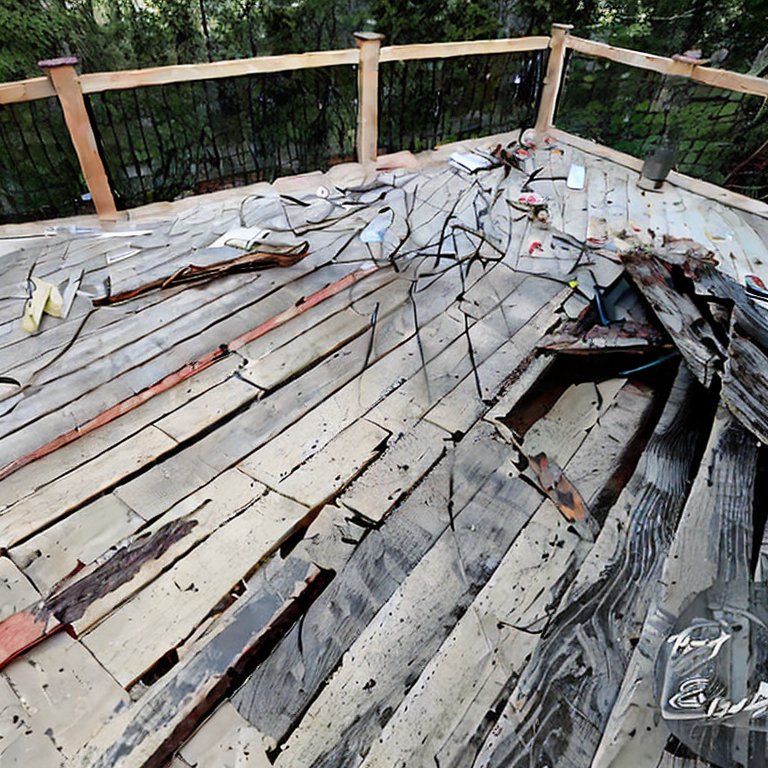Learn when to repair your deck and keep it in top-notch condition. From identifying common issues to choosing the right time for repairs, this comprehensive guide will help you maintain a safe and stunning outdoor space.
In this guide, we’ll explore the critical question, “When to repair your deck?” and provide you with insights, tips, and guidance to keep your deck in excellent shape throughout the seasons.
When to repair your deck?
Contents
Transforming your backyard into a cozy oasis with a beautiful deck is an investment that enhances your outdoor living experience. However, like any other structure, decks require regular maintenance and occasional repairs to ensure their longevity and safety. Keep reading as we delve into the process to help you better understand how to know when you deck will need repairs.
Common Signs of Deck Damage
Before we dive into the ideal timing for deck repairs, let’s familiarize ourselves with common signs of deck damage. Keep an eye out for the following indicators that may suggest your deck needs attention:
- Loose or wobbly boards: If your deck’s boards feel unstable or wobble when you walk on them, it’s a clear indication that repairs are necessary.
- Rotting or decaying wood: Moisture, termites, and exposure to the elements can cause wood to rot or decay. Inspect your deck for any signs of soft or discolored wood, as it may indicate structural damage.
- Split or cracked boards: Over time, deck boards can develop splits or cracks due to weathering and regular use. These openings can compromise the deck’s integrity and should be addressed promptly.
- Sagging or uneven surface: A visibly uneven or sagging deck surface could indicate weak support beams or joists. It’s crucial to investigate and repair such issues promptly to prevent further damage.
- Rusted or corroded fasteners: Check the screws, nails, or other fasteners holding your deck together. If you notice signs of rust or corrosion, it’s important to replace them to maintain the structural integrity of your deck.
Determining the Right Time for Deck Repairs
Now that we’ve identified common signs of deck damage, let’s explore when it’s the right time to tackle those necessary repairs. Remember, proactive maintenance is key to preventing small issues from turning into major problems.
1. Spring Cleaning and Inspection
As the cold winter months fade away, it’s ideal to kickstart the deck repair process during the spring. This period allows you to:
- Conduct a thorough inspection: Take a walk around your deck and closely examine its structure, paying attention to any signs of damage mentioned earlier.
- Clean and prepare the deck: Clear away debris, leaves, and dirt that may have accumulated over the winter. A clean surface helps you identify potential issues more accurately.
2. Early Detection and Prompt Action
When you notice any of the signs mentioned above, don’t delay in taking action. Addressing problems early can save you from costly repairs down the line. Some issues that require immediate attention include:
- Safety hazards: If your deck poses a safety risk, such as loose railings or severely weakened structural components, repairs should be a top priority.
- Visible damage: Cracked or splintered boards, rotting wood, or deteriorated fasteners should be addressed promptly to prevent further damage and ensure the longevity of your deck.
- Water damage: Decks exposed to heavy rain or moisture can develop mold, mildew, and rot. Timely repairs can prevent these issues from spreading and compromising the entire structure.
3. Seasonal Maintenance
Performing regular maintenance tasks during different seasons can help identify and address minor problems before they escalate. Consider these maintenance activities based on the time of year:
Summer:
- Inspect for sun damage: Check for signs of sun discoloration or fading on your deck’s surface. Consider applying a protective sealant to prevent further damage.
- Clean and reseal: Summer is a great time to clean your deck thoroughly and apply a fresh coat of sealant to protect it from UV rays and moisture.
Fall:
- Clear fallen leaves: Regularly remove leaves and debris that can accumulate on your deck during the fall. Moisture trapped beneath leaves can lead to mold and rot.
- Inspect for winter readiness: Check for any signs of damage or wear that may worsen during the upcoming winter months. Address them before the harsh weather arrives.
Winter:
- Snow removal: Clear snow from your deck promptly to prevent excess weight and moisture buildup. Use a plastic shovel or a broom to avoid scratching the surface.
- Ice control: Apply ice melt or sand on icy spots to prevent slips and falls. Avoid using harsh chemicals that could damage the deck’s finish.
- Indoor storage: If possible, consider storing patio furniture and other items indoors during the winter to minimize the stress on your deck.


What are the most common deck repair mistakes to avoid?
When it comes to repairing your deck, it’s essential to steer clear of common pitfalls that can turn a simple fix into a major headache. By avoiding these mistakes, you’ll save yourself time, money, and frustration. So, let’s dive into the top blunders to sidestep when tackling deck repairs:
- Skipping regular inspections: Neglecting to inspect your deck regularly can lead to minor issues turning into significant problems. Make it a habit to check for loose boards, rot, or any signs of damage to catch them early on.
- Using improper materials: Don’t be tempted to cut corners by using subpar materials for repairs. Ensure you choose high-quality wood, fasteners, and sealants that are suitable for outdoor use, as using the wrong materials can result in premature deterioration.
- Neglecting safety measures: Safety should always be a top priority when working on your deck. Avoid working at heights without proper scaffolding or ladders, and wear appropriate protective gear, such as goggles and gloves, to prevent accidents and injuries.
- Failing to address underlying issues: Merely fixing the visible damage without addressing the underlying cause is a recipe for disaster. Identify and resolve the root cause of the problem to ensure a long-lasting repair.
- Overlooking proper waterproofing: Your deck is exposed to the elements, making waterproofing a crucial step. Failing to apply a sealant or waterproofing product can lead to water damage, rot, and the need for frequent repairs.
Remember, when it comes to deck repairs, it’s better to take your time, do it right the first time, and avoid these common mistakes to ensure a sturdy and beautiful outdoor space that will stand the test of time.
What are the long-term benefits of timely deck repairs?
Repairing your deck in a timely manner offers numerous long-term advantages that go beyond simply fixing visible issues. Let’s explore the benefits of tackling deck repairs promptly:
- Enhanced safety: Timely repairs ensure that your deck remains structurally sound, reducing the risk of accidents and injuries. By addressing issues like loose boards, weak support beams, or deteriorated fasteners, you create a safe environment for your family and guests to enjoy.
- Prevention of further damage: Small deck problems, if left unattended, can quickly escalate and cause more significant damage. By addressing repairs promptly, you prevent issues from spreading and potentially compromising the entire deck’s integrity.
- Extended lifespan: A well-maintained deck lasts longer. Timely repairs prevent minor issues from developing into major structural problems, ultimately extending the lifespan of your deck and saving you from costly replacements.
- Cost savings: Fixing minor deck issues early on is more cost-effective than allowing them to worsen. Prompt repairs help you avoid expensive repairs or even complete deck reconstruction down the line.
- Preserving aesthetics: A well-maintained deck enhances the curb appeal of your home and provides a pleasant outdoor space for relaxation and entertainment. By addressing repairs promptly, you ensure that your deck remains visually appealing and inviting.
Investing time and effort in timely deck repairs not only saves you money and prolongs the life of your deck but also ensures the safety and beauty of your outdoor living space for years to come. So, don’t delay—address those repairs promptly and enjoy the long-term benefits.
FAQs about when to repair your deck
Q1: How often should I inspect my deck for damage?
A1: It is recommended to inspect your deck at least once a year, preferably during the spring. However, keep an eye out for any noticeable changes or signs of damage throughout the year.
Q2: Can I repair my deck myself, or should I hire a professional?
A2: Minor repairs like replacing individual boards or tightening loose screws can often be done by homeowners with basic DIY skills. However, for complex structural issues or extensive damage, it’s best to consult a professional deck contractor.
Q3: How long does deck repair typically take?
A3: The duration of deck repair depends on the extent of the damage and the complexity of the project. Minor repairs can be completed in a day or two, while major renovations may take several weeks.
Q4: Are there any preventive measures I can take to minimize deck damage?
A4: Absolutely! Regular cleaning, applying sealants, and keeping the deck clear of debris can significantly extend its lifespan. Additionally, conducting routine inspections and addressing minor issues promptly can help prevent major damage.
Conclusion on when to repair your deck
Knowing when to repair your deck is crucial to maintain its safety, beauty, and longevity. By keeping an eye out for common signs of damage, conducting regular inspections, and addressing issues promptly, you can enjoy your outdoor oasis with peace of mind. Remember, proactive maintenance is key, and when in doubt, consult a professional to ensure your deck remains a welcoming space for years to come.






